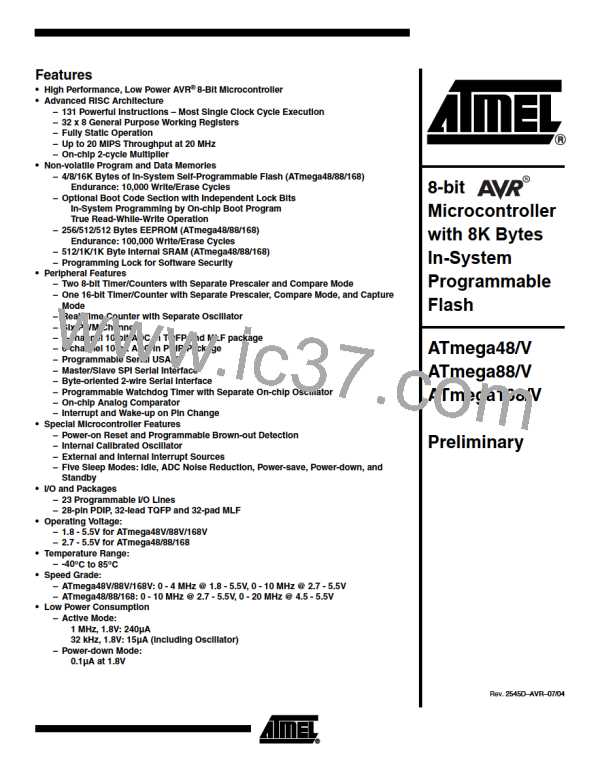The ADC Data Register –
ADCL and ADCH
ADLAR = 0
Bit
15
14
13
12
11
10
9
8
–
–
–
–
–
–
ADC9
ADC8
ADCH
ADCL
ADC7
ADC6
ADC5
ADC4
ADC3
ADC2
ADC1
ADC0
7
R
R
0
6
R
R
0
5
R
R
0
4
R
R
0
3
R
R
0
2
R
R
0
1
R
R
0
0
R
R
0
Read/Write
Initial Value
0
0
0
0
0
0
0
0
ADLAR = 1
Bit
15
14
13
12
11
10
9
8
ADC9
ADC8
ADC7
ADC6
ADC5
ADC4
ADC3
ADC2
ADCH
ADCL
ADC1
ADC0
–
5
–
4
–
3
–
2
–
1
–
0
7
R
R
0
6
R
R
0
Read/Write
Initial Value
R
R
0
R
R
0
R
R
0
R
R
0
R
R
0
R
R
0
0
0
0
0
0
0
0
0
When an ADC conversion is complete, the result is found in these two registers.
When ADCL is read, the ADC Data Register is not updated until ADCH is read. Conse-
quently, if the result is left adjusted and no more than 8-bit precision is required, it is
sufficient to read ADCH. Otherwise, ADCL must be read first, then ADCH.
The ADLAR bit in ADMUX, and the MUXn bits in ADMUX affect the way the result is
read from the registers. If ADLAR is set, the result is left adjusted. If ADLAR is cleared
(default), the result is right adjusted.
• ADC9:0: ADC Conversion Result
These bits represent the result from the conversion, as detailed in “ADC Conversion
Result” on page 241.
ADC Control and Status
Register B – ADCSRB
Bit
7
–
6
ACME
R/W
0
5
–
4
–
3
–
2
ADTS2
R/W
0
1
ADTS1
R/W
0
0
ADTS0
R/W
0
ADCSRB
Read/Write
Initial Value
R
0
R
0
R
0
R
0
• Bit 7, 5:3 – Res: Reserved Bits
These bits are reserved for future use. To ensure compatibility with future devices, these
bist must be written to zero when ADCSRB is written.
• Bit 2:0 – ADTS2:0: ADC Auto Trigger Source
If ADATE in ADCSRA is written to one, the value of these bits selects which source will
trigger an ADC conversion. If ADATE is cleared, the ADTS2:0 settings will have no
effect. A conversion will be triggered by the rising edge of the selected Interrupt Flag.
Note that switching from a trigger source that is cleared to a trigger source that is set,
will generate a positive edge on the trigger signal. If ADEN in ADCSRA is set, this will
244
ATmega48/88/168
2545D–AVR–07/04

 ATMEL [ ATMEL ]
ATMEL [ ATMEL ]